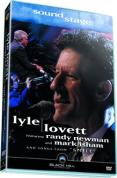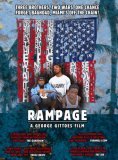![Gunner Palace [2004]](/pictures/1068276.jpg) Gunner Palace | DVD | (25/06/2007)
from £N/A
| Saving you £N/A (N/A%)
| RRP
Gunner Palace | DVD | (25/06/2007)
from £N/A
| Saving you £N/A (N/A%)
| RRP Some war stories will never make the nightly news. American soldiers of the 2/3 Field Artillery a group known as the ""Gunners "" tell of their experiences in Baghdad during the Iraq War. Holed up in a bombed out pleasure palace built by Sadaam Hussein the soldiers endured hostile situations some four months after President George W. Bush declared the end of major combat operations in the country.
 Lyle Lovett - Soundstage | DVD | (24/04/2006)
from £N/A
| Saving you £N/A (N/A%)
| RRP
Lyle Lovett - Soundstage | DVD | (24/04/2006)
from £N/A
| Saving you £N/A (N/A%)
| RRP Backed by a 14 piece big band and a 25 piece orchestra Grammy Award winning Lovett performs a number of songs from his 2003 album Smile. An album of beautiful tracks culled from an eclectic cross-section of recent American cinema including 'Summer Wind' (For The Love Of The Game) and the title track 'Smile' (Hope Floats). Lovett's minimalist style is combined with yet another legend the celebrated West Coast singer-songwriter Randy Newman. Together they perform the crowd plea
 Rampage | DVD | (19/04/2013)
from £6.74
| Saving you £3.25 (32.50%)
| RRP
Rampage | DVD | (19/04/2013)
from £6.74
| Saving you £3.25 (32.50%)
| RRP During the making of ""Soundtrack to War"" director Gittoes asks soldier Elliot Lovett how it feels to be in Iraq getting shot at Elliot's reply ""man I get shot at less here in Baghdad than at home in Miami"" sparks Gittoes imagination and he heads to Brownsville Miami to find out what is so bad about ""Brown Sub"" that would make Baghdad during the height of the second Iraq war feel safer. What Gittoes finds will stand testament to an America few want to acknowledge and none want to experience first hand.
![Red Dwarf Series 1 [DVD]](/pictures/1105623.jpg) Red Dwarf Series 1 | DVD | (07/03/2011)
from £N/A
| Saving you £N/A (N/A%)
| RRP
Red Dwarf Series 1 | DVD | (07/03/2011)
from £N/A
| Saving you £N/A (N/A%)
| RRP Notoriously, and entirely appropriately, the original outline for Doug Naylor and Rob Grant's comedy SF series Red Dwarf was sketched on the back of a beer mat. When it finally appeared on our television screens in 1988 the show had clearly stayed true to its roots, mixing jokes about excessive curry consumption with affectionate parodies of classic SF. Indeed, one of the show's most endearing and enduring features is its obvious respect for the conventions of SF, even as it gleefully subverts them. The scenario owes something to Douglas Adams's satirical Hitch-Hiker's Guide, something to The Odd Couple and a lot more to the slacker SF of John Carpenter's Dark Star. Behind the crew's constant bickering there lurks an impending sense that life, the universe and everything are all someone's idea of a terrible joke. Later series broadened the show's horizons until at last its premise was so diluted as to be unrecognisable, but in the six episodes of the first series the comedy is witty and intimate, focusing on characters and not special effects. Slob Dave Lister (Craig Charles) is the last human alive after a radiation leak wipes out the crew of the vast mining vessel Red Dwarf (episode 1, "The End"). He bums around the spaceship with the perpetually uptight and annoyed hologram of his dead bunkmate, Arnold Rimmer (Chris Barrie, the show's greatest comedy asset) and a creature evolved from a cat (dapper Danny John Jules). They are guided rather haphazardly by Holly, the worryingly thick ship's computer (lugubrious Norman Lovett). On the DVD: Red Dwarf I arrives in a two-disc set, with all six episodes on the first disc accompanied by an excellent group commentary from Craig Charles, Chris Barrie, Danny John Jules and Norman Lovett. (There's also a bonus commentary on "The End" with the two writers and director Ed Bye.) The 4:3 picture is unimpressive, but sound is decent stereo. The second disc has an entertaining 25-minute documentary on the genesis of the series with contributions from the cast, writer Doug Naylor and producer Paul Jackson. Navigate the animated menus to find a gallery of extra features, including isolated music cues, deleted scenes, outtakes ("Smeg Ups"), a fun "Drunk" music montage, model effects shots, Web links, audiobook clips, the original BBC trailer and even the entire first episode in Japanese. --Mark Walker
![Lyle Lovett Live [DVD]](/pictures/1092853.jpg) Lyle Lovett Live | DVD | (06/04/2009)
from £8.08
| Saving you £-2.09 (-34.90%)
| RRP
Lyle Lovett Live | DVD | (06/04/2009)
from £8.08
| Saving you £-2.09 (-34.90%)
| RRP Lyle Lovett
![Red Dwarf Series 2 [DVD]](/pictures/1105624.jpg) Red Dwarf Series 2 | DVD | (07/03/2011)
from £6.73
| Saving you £-1.74 (-34.90%)
| RRP
Red Dwarf Series 2 | DVD | (07/03/2011)
from £6.73
| Saving you £-1.74 (-34.90%)
| RRP The second series of Red Dwarf is, as Danny John-Jules says in the accompanying DVD commentary, "the one where it really went good". First broadcast in the autumn of 1988, these six episodes showcase Rob Grant and Doug Naylor's sardonic, sarcastic humour to perfection. The writing has matured, no longer focussing solely on SF in-jokes and gags about bodily functions, instead allowing the humour to develop from the characters and their sometimes surprisingly poignant interactions: Lister's timeless love for Kochanksi, for example, or Rimmer's brief memory-implanted love for one of Lister's ex-girlfriends. The cast had gelled, too, and there's even more colour this year as the drab sets are spiced up, a little more money has been assigned to models and special effects, and the crew even go on location once in a while. "Kryten" introduces us to the eponymous house robot (here played by David Ross), although after this first episode he was not to reappear until Series 3, when Robert Llewellyn made the role his own. Then in "Better Than Life" the show produced one of its all-time classic episodes, as the boys from the Dwarf take part in a virtual reality game that's ruined by Rimmer's tortured psyche. Other highlights include "Queeg", in which Holly is replaced by a domineering computer personality, the baffling time travel paradox of "Stasis Leak", the puzzling conundrum of "Thanks for the Memory", and the astonishingly feminine "Parallel Universe". On the DVD: Red Dwarf, Series 2 has another chaotic and undisciplined group commentary from the cast, all clearly enjoying the opportunity to reminisce. The second disc has a host of fun extras, including an "A-Z of Red Dwarf", outtakes, deleted scenes, a Doug Naylor interview, model shots, and the full, unexpurgated "Tongue Tied" music video. As with the first set, the animated menus are great fun and the "Play All" facility is the most useful little flashing button ever created. --Mark Walker
![Schubert/Britten - String Quartet No. 12/String Quartet No.2 [2005]](/pictures/1067800.jpg) Schubert/Britten - String Quartet No. 12/String Quartet No.2 | DVD | (04/04/2005)
from £N/A
| Saving you £N/A (N/A%)
| RRP
Schubert/Britten - String Quartet No. 12/String Quartet No.2 | DVD | (04/04/2005)
from £N/A
| Saving you £N/A (N/A%)
| RRP To be able to see the Amadeus Quartet if full colour playing congenial repertoire in one of their favorite venues and at the height of their powers is a wonderful privilege. To those of us who were fortunate enough to attend some of their concerts it will bring back imperishable memories.

Please wait. Loading...
This site uses cookies.
More details in our privacy policy